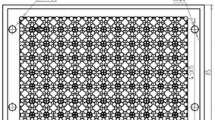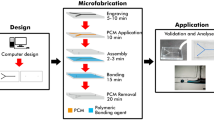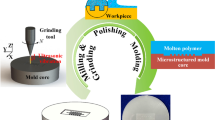Abstract
Microfluidics has been widely used in biological, chemical, medical and environmental fields for the precise control of liquid in micro/nanoscale. Various fabrication methods have been invented based on polymer materials in the past decade. Currently, under the circumstance of massive fabrication of microfluidic devices, injection molding is still the cheapest and fastest approaches. Injection molding products have been widely used in everyday life, however, the injection molding of polymer-based microfluidics has not been extensively investigated in the previous studies. In this study, we proposed a relatively comprehensive fabrication procedure for the injection molding of polymer microfluidic chips: the testing microfluidic chip with typical microfluidic components were designed, followed with mold design and fabrication; a single screw injection molding machine was used for the fabrication of PMMA-based microfluidic chips under different processing parameters; finally, another layer of polymer sheet was bonded to seal the microchannel and chip’s functionality was tested. The profile of the fabricated microchannels, as well as surface quality under difference injection molding parameters was also discussed in this study. This study is trying to provide a comprehensive injection molding approach for polymer-based microfluidics, the chip and injection mold design process, as well as the injection molding parameters, could have reference value for the future massive production of polymer microfluidic chips for biological and medical applications.









Similar content being viewed by others
References
Auner AW et al (2019) Chemical-PDMS binding kinetics and implications for bioavailability in microfluidic devices. Lab Chip 19(5):864–874
Bhattacharjee N et al (2016) The upcoming 3D-printing revolution in microfluidics. Lab Chip 16(10):1720–1742
Choi C-H, Lee H, Weitz DA (2018) Rapid patterning of PDMS microfluidic device wettability using syringe-vacuum-induced segmented flow in nonplanar geometry. ACS Appl Mater Interfaces 10(4):3170–3174
Chung S et al (2019) Smartphone-based paper microfluidic particulometry of norovirus from environmental water samples at the single copy level. ACS Omega 4(6):11180–11188
Hou X et al (2017) Interplay between materials and microfluidics. Nat Rev Mater 2(5):17016
Klank H, Kutter JP, Geschke O (2002) CO 2-laser micromachining and back-end processing for rapid production of PMMA-based microfluidic systems. Lab Chip 2(4):242–246
Lee UN et al (2018a) Fundamentals of rapid injection molding for microfluidic cell-based assays. Lab Chip 18(3):496–504
Lee Y et al (2018b) Microfluidics within a well: an injection-molded plastic array 3D culture platform. Lab Chip 18(16):2433–2440
Liang C et al (2018) One-step selective-wettability modification of PMMA microfluidic devices by using controllable gradient UV irradiation (CGUI). Sensors and Actuators B: Chemical 273:1508–1518
Lin T-Y et al (2017) 3D printed metal molds for hot embossing plastic microfluidic devices. Lab Chip 17(2):241–247
Liu S et al (2018) Fabrication of cyclo-olefin polymer-based microfluidic devices using CO2 laser ablation. Mater Res Express 5(9):095305
Mair DA et al (2006) Injection molded microfluidic chips featuring integrated interconnects. Lab Chip 6(10):1346–1354
Mathur A et al (2009) Characterisation of PMMA microfluidic channels and devices fabricated by hot embossing and sealed by direct bonding. Curr Appl Phys 9(6):1199–1202
Newman S et al (2019) High density DNA data storage library via dehydration with digital microfluidic retrieval. Nat Commun 10(1):1706
Pentecost AM, Martin RS (2015) Fabrication and characterization of all-polystyrene microfluidic devices with integrated electrodes and tubing. Anal Methods 7(7):2968–2976
Sanjoh A, Tsukihara T (1999) Spatiotemporal protein crystal growth studies using microfluidic silicon devices. J Cryst Growth 196(2–4):691–702
Sontheimer-Phelps A et al (2019) Modelling cancer in microfluidic human organs-on-chips. Nat Rev Cancer 19(2):65–81
Sticker D et al (2015) Multi-layered, membrane-integrated microfluidics based on replica molding of a thiol–ene epoxy thermoset for organ-on-a-chip applications. Lab Chip 15(24):4542–4554
Su S et al (2019) One-step bonding and hydrophobic surface modification method for rapid fabrication of polycarbonate-based droplet microfluidic chips. Sens Actuators B Chem 282:60–68
Tsao C-W (2016) Polymer microfluidics: simple, low-cost fabrication process bridging academic lab research to commercialized production. Micromachines 7(12):225
Viehrig M et al (2018) Injection-molded microfluidic device for SERS sensing using embedded Au-capped polymer nanocones. ACS Appl Mater Interfaces 10(43):37417–37425
Wan AM, Devadas D, Young EW (2017) Recycled polymethylmethacrylate (PMMA) microfluidic devices. Sens Actuators B Chem 253:738–744
Wang X et al (2016) A disposable, roll-to-roll hot-embossed inertial microfluidic device for size-based sorting of microbeads and cells. Lab Chip 16(10):1821–1830
Acknowledgements
This work was supported by the National Natural Science Foundation of China (No. 51804014) and Beijing Natural Science Foundation (2182055).
Author information
Authors and Affiliations
Corresponding author
Additional information
Publisher's Note
Springer Nature remains neutral with regard to jurisdictional claims in published maps and institutional affiliations.
Rights and permissions
About this article
Cite this article
Ma, X., Li, R., Jin, Z. et al. Injection molding and characterization of PMMA-based microfluidic devices. Microsyst Technol 26, 1317–1324 (2020). https://doi.org/10.1007/s00542-019-04662-2
Received:
Accepted:
Published:
Issue Date:
DOI: https://doi.org/10.1007/s00542-019-04662-2




